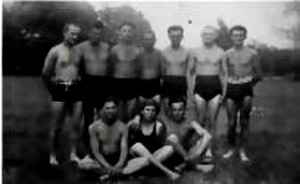 |
(members of Hanoar Hatzioni and Hashomer Hatzair)
|
Translated by Dorothy Gross Nadosy
Smaller cities than Beregszász have provided world champions. We did not have the champions, but it looks as if it was the only city in Transcarpathia that gave the soccer team (Czechoslovakia and then Hungary) a representative because, as worldwide, soccer was our most popular sport. As long as the atmosphere was free, the place of Jews always was secure in the sport. The sports league representing the town was the BFTC [Beregszász Futball and Tennis Club] and in in management and in the group, Jewish athletes were represented strongly. (Among the leaders of the soccer division were Ernö Hartmann and Dudi Hausmann.)
We remember “establishments” where Jews were the majority. We also may forget someone here, but we think it is right to capture the names of Jewish athletes who were the most well–known, so we compiled a list of Jewish players who played on the first team:
And the “reserves”: Sanyi Becksi, Zoli Katz, “Dacu” Salamon.
Jewish players came from the Zionist sports associations, which played an important role for the Jewish youth. Excellent elite BFTC team players developed from the first “Hakoach” team. The younger ones played in the “Hanoar” team. With the arrival of the Hungarians, Jews were gradually left out of the sports life. Hakoach won the youth championship in 1934–35, which caused envy in those defeated by us. The Hungarians did not act in a sportsmanlike manner with these “Maccabees”; the “judge” with a ridiculous decision simply stole the championship. The other adult team of the city was a representative of the “workers' sport” group BMSE [Budakalászi Workers' Sports Association], where there were Jews, including the most popular goalkeeper Nasi Markovits.
One almost “exclusively Jewish” sport in the city was tennis. This sport was mainly played by the children of wealthy households. (Poor families could not afford expensive equipment.) The local champions were all Jews. We highlight the most distinguished, the three sets of brothers who in reality were the frame of the city's tennis team: the Kálmán, Kertész, and Székely brothers.
In other sports, such as track and field, swimming, boxing, etc., they were not particularly active. But sometimes in these branches, there were tournaments, athletic days, especially in schools – everywhere we found excellent Jewish athletes because the Jewish youth of the city did not feel any inferiority to the others, who did not overwhelm them in this field. On the contrary, Jewish sports societies were the initiators and organizers of “sport days”, running competitions and other events.
If we take into account the number of Jews in the city's population and their activities in sports – for example, accounting for almost half of those selected for the leading soccer team – all this proves the high level of Jewish sports education. And from here to the abstract question raised in the previous chapter, there is not much distance. We often wonder what would have happened during the tragic trials if this couple of hundred young athletes and sportsmen had been there? This question will never leave our generation in peace.
The end was like in other areas of life. Shortly after the Hungarian occupation, some Jews were still in general associations, but their number dropped dramatically. When the Jewish youth were drafted into the labor camps, made to work in forced labor, sporting activities, like other areas of life, also were disrupted – In Beregszász, sports also were free of Jews.
Every governing system in all of the hypocritical states did not cease to preach the sport's lofty vocation: sports that unite peoples without race, class, and world view. We have a humble request here for the “chivalrous” Magyars: look at the pictures in this chapter. Strong, muscular youths in uniform, the sons of both peoples entwined and mingled with smiles. There is a natural co–operation between them on the sports grounds and beyond. If they win, they are happy to fall into each other's necks. And then suddenly the world turns: one (not us) does not look at the other, does not thank him or her, is indifferent to the fate of the friend, and may be actively involved in destroying yesterday's team captain!
What kind of “human” excuse can you bring up here? How did the Germans force you to do this? Do the subjugators force a “heroic” and “chivalrous” people to surrender? What remains of the honor of the people who kick and scratch those faithful soldiers and officers who fought for your homeland less than thirty years ago and have more honors embellishing their breasts than your soldiers?
They forgot the warriors and forgot the facts with insensitive blindness: how many Jewish athletes between the two world wars brought Olympic laurels and international victories to Hungary. It reminds me that for the “chivalrous” people, a foot also was exposed.
|
|
(members of Hanoar Hatzioni and Hashomer Hatzair) |
|
|
|
|
|
|
|
|
|
|
|
|
|
|
|
|
|
|
|
|
|
|
|
JewishGen, Inc. makes no representations regarding the accuracy of
the translation. The reader may wish to refer to the original material
for verification.
JewishGen is not responsible for inaccuracies or omissions in the original work and cannot rewrite or edit the text to correct inaccuracies and/or omissions.
Our mission is to produce a translation of the original work and we cannot verify the accuracy of statements or alter facts cited.
 Berehove, Ukraine
Berehove, Ukraine
 Yizkor Book Project
Yizkor Book Project
 JewishGen Home Page
JewishGen Home Page
Copyright © 1999-2025 by JewishGen, Inc.
Updated 23 Apr 2021 by LA